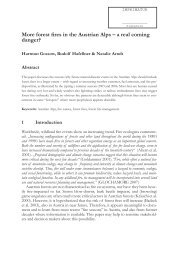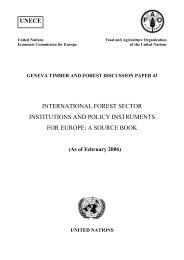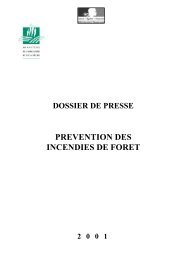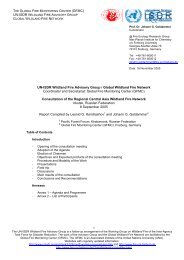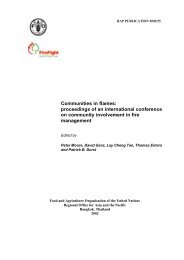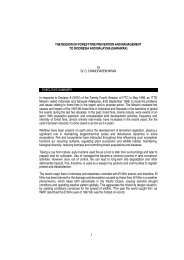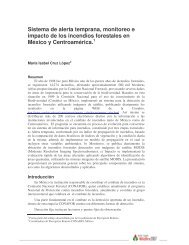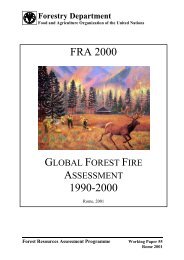Here's the Title1 - The Global Fire Monitoring Center
Here's the Title1 - The Global Fire Monitoring Center
Here's the Title1 - The Global Fire Monitoring Center
You also want an ePaper? Increase the reach of your titles
YUMPU automatically turns print PDFs into web optimized ePapers that Google loves.
Forest fire risk reduction techniques in <strong>the</strong><br />
community forests of Nepal 1<br />
Bhoj Raj Khanal 2<br />
Abstract<br />
Forest fires occur annually in all <strong>the</strong> major climatic regions of Nepal, including <strong>the</strong> Terai3 and<br />
inner Terai. By destroying natural vegetation, forest fires are degrading Nepal’s biological<br />
diversity. <strong>The</strong>re are several causes of community forest fires: hunting and poaching of wild<br />
animals (23%); throwing cigarettes (19%); intentional fires to hasten <strong>the</strong> growth of grass fed<br />
to livestock (18%); collection of herb and honey (8%); children playing (8%); security from<br />
armed groups (6%); and collection of charcoal (5%). Unknown reasons comprised 4% of <strong>the</strong><br />
causes of forest fires.<br />
Community people are knowledgeable about <strong>the</strong> hazards and causes of forest fires. <strong>The</strong>refore,<br />
<strong>the</strong>ir involvement is necessary for fire hazard reduction. Community-based organizations can<br />
provide solutions to <strong>the</strong> problem of forest fires. Community level fire control groups should<br />
be formed and trained on fire prevention and provided with fire fighting equipment. <strong>The</strong> topdown<br />
approaches adopted by government have failed to address <strong>the</strong> specific needs of<br />
vulnerable communities and ignored indigenous capacities and mechanisms. A fire<br />
forecasting system can help community forest users’ group and o<strong>the</strong>r stakeholders to manage<br />
and conserve <strong>the</strong> fire prone areas more effectively and efficiently. Both community-based and<br />
scientific knowledge and technology should be embraced and applied.<strong>The</strong> results of this study<br />
will be disseminated through workshops at <strong>the</strong> national and district levels. <strong>The</strong> research<br />
outputs will also be published in English and Nepalese languages (in booklet and leaflet<br />
forms) and will be distributed to <strong>the</strong> stakeholders of <strong>the</strong> community forests.<br />
Introduction<br />
Forest resources enable people, especially rural households in mid-hills and inner<br />
Terai, to earn <strong>the</strong>ir daily living in Nepal. One million hectares of forest have already<br />
been handed over to 14,000 community forest users’ groups (CFUG) in Nepal (DoF,<br />
2004). <strong>The</strong> District Forest Office (DFO) in Chitwan has formed 47 FUGs and has<br />
handed over forests at <strong>the</strong> community level until 2004 (DFO Chitwan, 2004).<br />
Nepal does not have actual data about <strong>the</strong> number of fires, severity, and amount of<br />
loss. None<strong>the</strong>less, forest fires occur annually in all major climatic regions of <strong>the</strong><br />
country, including <strong>the</strong> Terai and inner Terai regions, during <strong>the</strong> dry season from<br />
February to May. Once <strong>the</strong> monsoon season starts in <strong>the</strong> middle of June, <strong>the</strong> forest<br />
fire problem disappears in <strong>the</strong> country.<br />
1 Paper to present in <strong>the</strong> 4 th International Wildland <strong>Fire</strong> Conference, May 14-71, 2007 at Seville, Spain<br />
2 Research Manager, Mekong Institute, Khon Kaen University, Khon Kaen 40002, Thailand, Tel: 66-4-<br />
320-2411 Ext 401, Email: bhojrajkhanal@yahoo.com, research@mekonginstitute.org<br />
3 <strong>The</strong> Terai region is composed of a 26 to 32 km wide broad belt of alluvial and fertile plain in <strong>the</strong><br />
sou<strong>the</strong>rn part of Nepal. This belt extends from <strong>the</strong> westernmost part of <strong>the</strong> country to <strong>the</strong> eastern limit<br />
and covers about 17% of <strong>the</strong> total land area
Session No.—part of <strong>the</strong> title—authors’ last names<br />
Forest fires degrade <strong>the</strong> soil, inducing floods and landslides. <strong>The</strong> risk of forest fires<br />
from state owned forests is high and destroys community forests (CFs). However,<br />
<strong>the</strong>re is no systematic plan to reduce and prevent fire hazards. With difficult<br />
topographical conditions, hot and dry climate, low level of education, lack of<br />
property, dependency on forest resources, and lack of proper extension activities, CFs<br />
have difficulties coping with forest fires. Illegal logging, accidental burning,<br />
carelessness, intentional fires, and encroachment on forest land for cropping and<br />
infrastructure development have destroyed <strong>the</strong> forest cover. Cattle grazing, smokers,<br />
and accidental burning comprise 54% of <strong>the</strong> known causes of forest fires; while 32%<br />
are of unknown causes (Sharma, 1996).<br />
<strong>The</strong> latest forest inventory has indicated that from 1978 to 1994, Nepal’s forest cover<br />
decreased from 38% of <strong>the</strong> land area to 29%. Ano<strong>the</strong>r 10.6% of <strong>the</strong> land area is under<br />
shrub cover and about 45% had been covered with forest until 1966. <strong>The</strong> annual<br />
deforestation rate is estimated at 1.7%, of which forest fire is a major cause (<strong>The</strong><br />
Kathmandu Post, April 3 2001). Forest fires cause <strong>the</strong> movement of dry air with<br />
smoke and pollutant gases that affect <strong>the</strong> health of people. Sharma (1996) observed<br />
that about 90% of <strong>the</strong> Terai forests were burned in 1995. Earlier observations<br />
[Goldammer (1993) cited in Sharma (1996)] confirm this. <strong>The</strong> estimated burned area<br />
of forest is more than 400,000 hectares, with fires burning at least 100 villages<br />
annually. In 1998, 20 reported incidents of fires in 15,140 hectares of forest area<br />
resulted in huge losses to life, property, and endangered species of flora and fauna.<br />
<strong>The</strong> estimated cost was USD 127,500.<br />
<strong>The</strong> specific objectives of <strong>the</strong> research are <strong>the</strong> following:<br />
1. To document existing forest fire risk reduction techniques in CFs.<br />
2. To find out <strong>the</strong> causes and effects of forest fire in CFs.<br />
3. To outline <strong>the</strong> role of stakeholders to reduce <strong>the</strong> risk of forest fire in CFs.<br />
4. To promote policies and appropriate mechanisms on forest fire risk reduction<br />
in <strong>the</strong> CFs.<br />
Study Area<br />
Chitwan district was selected as <strong>the</strong> study site because it is one of <strong>the</strong> fire-prone<br />
districts located in <strong>the</strong> central part of <strong>the</strong> country. <strong>The</strong> CFs were selected from <strong>the</strong><br />
buffer zone and non-buffer zone forests where fires occur annually. <strong>The</strong> CFs from <strong>the</strong><br />
buffer zones were: Chitrasen Buffer Zone CF, Daksin Kali Buffer Zone CF, and<br />
Milijuli Buffer Zone CF. <strong>The</strong> CFs from <strong>the</strong> non-buffer zones were: Panchakanya CF,<br />
Satanchuli CF, and Jaladevi CF. <strong>The</strong> following two maps show <strong>the</strong> Chitwan District<br />
and its forest patches:
Session No.—part of <strong>the</strong> title—authors’ last names<br />
Map 1. Map of Nepal showing Chitwan<br />
District<br />
Map 2. Map of Chitwan showing Forest<br />
Patches<br />
Research Methods<br />
Both primary and secondary data were collected. Secondary data was obtained from<br />
<strong>the</strong> Department of Forest (DoF), DFO-Chitwan, Chitwan National Park (CNP),<br />
National Trust for Nature Conservation (NTNC), Department of National Park and<br />
Wildlife Conservation, Forestry Research Division, NGOs working in <strong>the</strong> CF<br />
management, and concerned FUGs from buffer zones and non-buffer zones. Primary<br />
data was collected from <strong>the</strong> institutional survey of selected FUGs and members’<br />
household survey. <strong>The</strong> data ga<strong>the</strong>red included causes of fire, effects of fire, fire types,<br />
duration of forest fires, and monthly distribution of forest fire incidents throughout<br />
<strong>the</strong> year. <strong>The</strong> following risk reduction mechanisms for forest fires were considered:<br />
extension programs, workshops, enforcement of laws and regulations, fuel<br />
management-fire line construction, control burning along <strong>the</strong> fire lines and<br />
construction forest tracks and roads, and clear demarcation of forests. Round table<br />
discussions were held with forestry professionals (DFO, NTNC, and CNP) and<br />
community people to compile <strong>the</strong>ir knowledge and experiences on forest fire risk<br />
reduction. Six focus group discussions (three each in buffer zone and non-buffer<br />
zone) were held to find <strong>the</strong> causes, effects, and indigenous techniques that CFs were<br />
using. During <strong>the</strong> dry season (February to May), <strong>the</strong> research team observed <strong>the</strong><br />
damage caused by forest fires in <strong>the</strong> study area.<br />
Key Findings<br />
Causes of Forest <strong>Fire</strong>s. According to Sharma (1996), <strong>the</strong> fuels in <strong>the</strong> forest areas are<br />
highly combustible. Fuels found in <strong>the</strong> layers of Sal (Shorea robusta) leaves and o<strong>the</strong>r<br />
species comprise about 90%. O<strong>the</strong>r surface fuels are from twigs and grasses. Some<br />
10.7 tons of fuel can be found over dry areas.<br />
<strong>The</strong>re are two categories of <strong>the</strong> causes of forest fires: intended and unintended. In <strong>the</strong><br />
former category, people deliberately start a fire in <strong>the</strong> forest to collect herbs, to hunt,<br />
and to hasten <strong>the</strong> growth of new grasses to feed livestock and use for roof cover in<br />
<strong>the</strong>ir village. <strong>The</strong> latter category consists of unextinguished cigarettes carelessly<br />
thrown away, burning of agricultural products, children playing, control burning that<br />
later becomes unmanageable, and careless travelers.<br />
<strong>The</strong> following are <strong>the</strong> observed causes of forest fires in <strong>the</strong> selected six FUGs in <strong>the</strong><br />
buffer zone and non-buffer zone.<br />
Table 1. Causes of Forest <strong>Fire</strong>s in <strong>the</strong> Buffer Zone CFs and Non-buffer Zone CFs
Session No.—part of <strong>the</strong> title—authors’ last names<br />
Causes of Forest<br />
Buffer Zone CFs Non-buffer Zone CFs Averag<br />
<strong>Fire</strong> CBZCF DKBZCF MJBZCF PCF SCCF JDCF e (%)<br />
To hasten growth of<br />
new grass<br />
10 10 45 10 10 20 17.5<br />
Cigarettes 20 20 10 20 20 20 18.33<br />
Collection of<br />
herb/honey<br />
5 - 5 10 25 5 8.33<br />
Collection of charcoal 10 10 - - 10 5<br />
Hunting/poaching of<br />
wild animals (wild<br />
boar and o<strong>the</strong>rs)<br />
30 20 20 15 25 30 23.33<br />
Playing children and<br />
cattle herders<br />
5 20 - 10 10 - 7.5<br />
Security reasons<br />
(from state and rebel<br />
groups)<br />
- 10 - 15 10 6.0<br />
To get rid of wild<br />
animals<br />
10 10 15 10 10 5 10<br />
Unknown reasons 10 - 5 10 - - 4.0<br />
Acronyms: CBZCF: Chitrasen Buffer Zone Community Forest, DKBZCF: Daksin Kali Buffer Zone Community<br />
Forest, MJBZCF: Milijuli Buffer Zone Community Forest, PCF: Panchakanya Community Forest, SCCF:<br />
Satanchuli Community Forest, JDCF: Jaladevi Community Forest<br />
<strong>The</strong> observed causes of fires in CFs are largely anthropogenic. <strong>The</strong>y are as follows:<br />
hunting and poaching of wild animals (23%); throwing of cigarettes (19%);<br />
intentional fires to hasten <strong>the</strong> growth of grass fed to livestock (18%); collection of<br />
herb and honey (8%); children playing (8%); security from armed groups (6%); and<br />
collection of charcoal (5%). Unknown reasons comprised 4% of <strong>the</strong> causes of forest<br />
fires.<br />
<strong>The</strong> effects of seasonal forest fires can be very destructive, resulting in <strong>the</strong> loss of<br />
human lives, timber and non-timber forest products, livestock, and wild animals.<br />
With burned trees, stumps, flowers, grains, and seed, and damage to natural resources<br />
such as watersheds, <strong>the</strong> environment’s recovery from forest fires may take several<br />
years. <strong>The</strong> destruction of animal and insect habitat causes imbalance in <strong>the</strong><br />
ecosystem. <strong>The</strong> change in soil texture affects its capacity to hold water, kills<br />
microorganisms, and reduces organic matter in <strong>the</strong> soil. Smoke from forest fires<br />
causes haze in <strong>the</strong> villages, diminishing air quality.<br />
In regions affected by forest fires, climate patterns become irregular because of <strong>the</strong><br />
heat that rises to <strong>the</strong> atmosphere, contributing to global warming.<br />
Community Based Forest <strong>Fire</strong> Management and Risk Reduction Techniques.<br />
Community people have developed <strong>the</strong>ir own methods and traditional ways of forest<br />
fire management. <strong>The</strong>se include: worshiping <strong>the</strong> forest goddess; planting evergreen<br />
trees along <strong>the</strong> trails; collecting forest litter for animal bedding and making compost;<br />
patrolling within <strong>the</strong>ir CFs; penalty and reward system for <strong>the</strong> villages; construction<br />
of small ponds, forest tract and fire lines inside <strong>the</strong> forest; and early and controlled<br />
burning in <strong>the</strong> fire prone areas.
Session No.—part of <strong>the</strong> title—authors’ last names<br />
<strong>The</strong> problems that CFs are facing include <strong>the</strong> following: insufficient plans and<br />
programs to control fire with DFO and NTNC; inadequate human and financial<br />
resources; insufficient extension programs for community people, especially cattle<br />
herders, school children, and collectors of non-timber forest products (NTFPs); lack<br />
of strong policy or fire control rules and regulations; and lack of specific fire control<br />
organization as DFO; and NTNC not prioritizing <strong>the</strong> forest fire risk reduction<br />
program.<br />
<strong>The</strong> top-down approaches adopted by government have failed to address <strong>the</strong> specific<br />
needs of vulnerable communities and ignored indigenous capacities and mechanisms.<br />
Community people are knowledgeable about <strong>the</strong> hazards and causes of forest fires.<br />
<strong>The</strong>refore, <strong>the</strong>ir involvement is necessary for fire hazard reduction. Communitybased<br />
organizations can provide solutions to <strong>the</strong> problem of forest fires. Sharing<br />
responsibilities, raising awareness, building capacity of FUGs, early warning and<br />
monitoring are <strong>the</strong> key aspects to streng<strong>the</strong>n fire risk reduction measures. In addition,<br />
community level fire control groups should be formed and trained on fire prevention<br />
and provided with fire fighting equipment.<br />
Existing Forest <strong>Fire</strong> Regulations and Organizations. Clause B, Section 49 of <strong>the</strong> 1993<br />
Forest Act, states that “starting a fire or doing anything that may cause a fire accident<br />
in natural forest is prohibited.” Clause 50 of <strong>the</strong> Act stipulates that “any person who<br />
commits such an offensive shall be punished with a fine of not more than 10,000<br />
Nepalese Rupees (approximately USD 140) or with imprisonment for a term not<br />
exceeding one year or both.” As <strong>the</strong> only legal provision for fire control, it is<br />
ineffective because it is extremely difficult to identify <strong>the</strong> offender. Every CF,<br />
however, has its own Operational Plan (OP) in forest fire management.<br />
During <strong>the</strong> season of forest fires, Nepal Radio and Nepal Television broadcast clips<br />
on forest fire prevention and fire fighting. <strong>The</strong> Community Forestry Division of DoF<br />
also publishes and distributes leaflets, booklets, posters in <strong>the</strong> fire-prone areas to<br />
make people aware of <strong>the</strong> risks. <strong>The</strong> DFO used to hire temporary fire watchmen to<br />
help CFs in preventing and fighting fires. However, <strong>the</strong> lack of training, resources,<br />
appropriate skills, and specific organizations made this initiative ineffective.<br />
Government support in <strong>the</strong> enactment of laws and policies for community based fire<br />
risk reduction and management is vital. DFO and NTNC have been ineffective<br />
because of <strong>the</strong> lack of resources; insufficient fire control and extension programs;<br />
inadequate fire control rules and regulations; absence of organizations responsible for<br />
preventing and fighting forest fires; and lack of proper risk reduction mechanisms.<br />
Preparedness consists of measures that enable governments, organizations,<br />
communities and individuals to respond rapidly and effectively to disaster situations<br />
(Carter, 1991). In <strong>the</strong> case of forest fires, it is important to formulate effective and<br />
updated counter disaster plans, provide a warning system, and implement public<br />
education, awareness, and training programs to FUG members.<br />
Recommendations<br />
Since <strong>the</strong> people are <strong>the</strong> main cause of fires in community forests,<br />
prevention and control must involve communities. <strong>Fire</strong> management<br />
includes monitoring, early warning, prevention, preparation, suppression,<br />
and restoration activities that <strong>the</strong> community can take part. Investing in
Session No.—part of <strong>the</strong> title—authors’ last names<br />
fire education and training programs will substantially reduce <strong>the</strong> number<br />
of fires and <strong>the</strong> cost of fire management. <strong>The</strong> cost of fire education<br />
campaigns is very low compared to costs entailed in controlling fires and<br />
recovering from fire-inflicted damages. It is strongly recommended that a<br />
significant portion of <strong>the</strong> budget be allocated to forest fire prevention.<br />
National Level Stakeholders are <strong>the</strong> DoF, Department of National Park and<br />
Wildlife Conservation, Community Forestry Division, NTNC, and Forest Research<br />
Division. Below are <strong>the</strong> recommendations for <strong>the</strong>m:<br />
• Include forest fire education in <strong>the</strong> school curriculum.<br />
• Use satellite imagery (GIS technology) in government offices to monitor forest<br />
cover change and fire extent throughout <strong>the</strong> country and disseminate <strong>the</strong><br />
information to CFs in fire-prone areas.<br />
• Develop training curriculum for “community-based forest fires risk reduction<br />
program.” This program should impart skills for FUG members on forest fires<br />
risk reduction and effective use of indigenous knowledge.<br />
• Conduct regular researches on forest fire to eliminate <strong>the</strong> repetition of previous<br />
mistakes, improve ongoing forest fire risk reduction capability, assist in<br />
reducing vulnerability to forest fire disasters, and stimulate forward-looking<br />
concepts for <strong>the</strong> future.<br />
• Form specific institutions to deal with fire prevention extension activities,<br />
human resources development, law enforcement, fire suppression, and fire<br />
research.<br />
• Prepare sufficient booklets, leaflets, and o<strong>the</strong>r educational materials (in local<br />
language with pictures) and distribute in <strong>the</strong> communities living in fire-prone<br />
forest areas.<br />
• Formulate policies based on forest fire researches.<br />
District Level Stakeholders are <strong>the</strong> DFO, CNP, District Development Committee<br />
(DDC), NTNC-District Office, and Federation of Community Forest Users’ Group.<br />
Below are <strong>the</strong> recommendations for <strong>the</strong>m:<br />
• Provide appropriate training and distribute materials among FUG members,<br />
school children, cow herders, and school teachers.<br />
• Identify a key partner institution to deliver training programs (including NGOs)<br />
and to enhance FUG members’ response and preparedness capacity.<br />
• Mobilize NGO resources to provide trainings to community leaders, teachers,<br />
and personnel on preventive measures of fires.<br />
• Set up an early warning and communication system among community forests<br />
for possible outbreak of forest fires, and coordinate with o<strong>the</strong>r CFs.<br />
• Enforce laws, regulations, and restrictions on community forests regarding fires.<br />
• Authorities and communities should work as partners. Authorities should refrain<br />
from adopting top-down approaches with communities.<br />
• Assist CFs to formulate effective and updated fire disaster plans.<br />
• Prepare a detailed report about <strong>the</strong> occurrence, damage, and impact of fire and<br />
disseminate to all stakeholders.<br />
• Conduct researches on local people’s use of fire, yearly number of fires and<br />
burned areas, number of fires, fire distribution and direction, duration, monthly
Session No.—part of <strong>the</strong> title—authors’ last names<br />
distribution of fire incidents throughout <strong>the</strong> season, and impact on <strong>the</strong> different<br />
ecosystems.<br />
Community Level Stakeholders are <strong>the</strong> CFUGs, Community People, Village<br />
Development Committee (VDC), Range Posts, and SAHARA—a local NGO. Below<br />
are <strong>the</strong> recommendations for <strong>the</strong>m:<br />
• Clear demarcation and fencing of forest areas to prevent children and travelers<br />
from entering.<br />
• Raise awareness on <strong>the</strong> proper use of flammable materials among FUG members,<br />
school children, cow herders, and school teachers.<br />
• Form teams of fire fighting volunteers in fire prone areas<br />
• Construct fire lines, forest track, ponds, and canals according to <strong>the</strong> forest<br />
operational plan.<br />
• Practice fuel management and control burning before fire season.<br />
• Regularly organize fire prevention and suppression campaigns.<br />
• Raise community people’s awareness on safe forest fire risk reduction<br />
techniques.<br />
• Train FUG members and o<strong>the</strong>r community people on <strong>the</strong> techniques to<br />
extinguish fires.<br />
• Promptly detect fires through observation points, patrolling, communication<br />
network, fire forecasting (early warning system), and coordinating with nearby<br />
CFs.<br />
• During fire incidents, clean fire lines and forest tracks if <strong>the</strong>re are forest areas<br />
nearby so that fire would not spread from villages to <strong>the</strong> forest areas and vice<br />
versa.<br />
• Conduct research to find <strong>the</strong> causes of fire and plan for future.<br />
Acknowledgement<br />
<strong>The</strong> author expresses his sincere appreciation to <strong>the</strong> ProVention Consortium and <strong>the</strong><br />
Asian Disaster Preparedness <strong>Center</strong> (ADPC) for providing <strong>the</strong> research grant,<br />
invaluable support, and guidance throughout <strong>the</strong> study period.
Session No.—part of <strong>the</strong> title—authors’ last names<br />
References<br />
Abarquez, I. and Murshed, Z. (2004). Community Based Disaster Risk Management<br />
Field Practitioners’ Handbook. Bangkok, Thailand: ADPC, UNESCAP and EU.<br />
ADPC (2004). Asian Disaster Management News (Vol 10, No. 1). October- December<br />
2004. Bangkok, Thailand<br />
Bajracharya, K.M. (2001), <strong>The</strong> Forest <strong>Fire</strong> Situation in Nepal. , Int. Forest <strong>Fire</strong> News26<br />
http://www.fao.org/documents/show_cdr.asp?url_file=/docrep/006/ad65<br />
3e/ad653e51.htm)<br />
Carter, W. N. (1991). Disaster Management: A Disaster Manager’s Handbook. Manila,<br />
Philippines: Asian Development Bank.<br />
DDC Chitwan (2004). Chitwan District Disaster Management Action Plan, Total<br />
Disaster Risk Management (TDRM) Pilot Exercise. Nepal: UNDP-DDC Chitwan.<br />
DoF (2004). Profile of Community Forest Users Groups’ in Nepal. Department of<br />
Forest, HMG/N.<br />
<strong>Fire</strong> Destroys <strong>the</strong> Forest. <strong>The</strong> Himalayan Times (Charikot, Nepal). March 27, 2005.<br />
KMTNC (2003). Community Forest Users Groups in Barandhabhar: A Brief Silhouette.<br />
Chitwan, Nepal: King Mahendra Trust for Nature Conservation, Biodiversity<br />
Conservation <strong>Center</strong>, Tiger Rhino Conservation Project<br />
Ministry of Forest and Soil Conservation (1993). Forest Act. His Majesty’s Government<br />
of Nepal.<br />
Sharma, S. P. (1996). Forest <strong>Fire</strong> in Nepal. Int. Forest <strong>Fire</strong> News) (http://www.fire.unifreiburg.de/iffn/country/np/np_1.htm).<br />
White, K. J. (1985). Forest <strong>Fire</strong> Control Strategies and Practices in <strong>the</strong> Bhabar Terai of<br />
Central Nepal (Manual No. 4). Kathmandu, Nepal: Ministry of Forest.<br />
http://www.fao.org/newsroom/en/news/2005/105836/index.html<br />
http://www.fao.org/newsroom/en/news/2005/105836/index.html<br />
http://www.ing.unitn.it/





